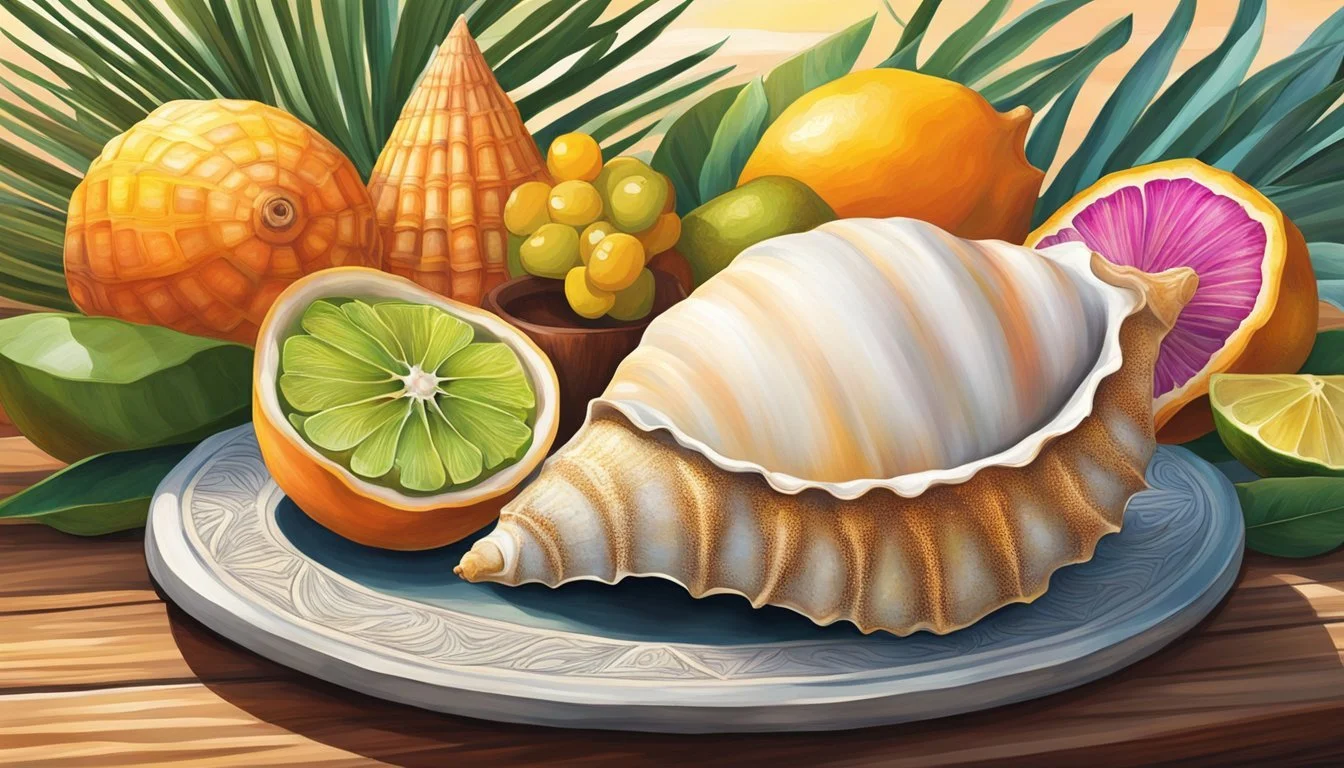Conch Cuisine Exploring the Delicacies of Sea Snail Dishes
Conch, often referred to as lambi in Haitian Creole, has long been a delicacy across the Caribbean and parts of the Indo-Pacific. Known for its tender meat and distinctive spiral shell, which sometimes measures up to 12 inches, conch presents a blend of both cultural significance and flavor. It graces many coastal menus and embodies the essence of sea snail cuisine, holding a revered spot on plates from the Bahamas to Key West.
Preparation methods for conch vary widely, revealing the versatility of this sea snail. It can be served as part of hearty stews, thinly sliced in fresh salads, or breaded and deep-fried. More intricate dishes involve tenderizing the conch meat through slow cooking or marinating before incorporating it into vibrant Creole dishes. The conch's mild, slightly sweet flavor profile makes it an excellent canvas for a variety of seasonings and cooking techniques, allowing it to absorb and complement the flavors it's paired with.
Historical Significance of Conch
Conch, the large sea snail found predominantly in warm Caribbean waters, has a rich history deeply intertwined with Caribbean cuisine and culture. The queen conch, a native species to the region, is particularly celebrated for its cultural significance and as a staple in traditional dishes.
Throughout the Caribbean, conch has been a prevalent source of sustenance for centuries. Indigenous peoples and later African influences shaped how conch is used in cooking, incorporating it into a variety of flavorful seafood dishes. In the Bahamas, conch is not only a key component of the culinary landscape, but it is also emblematic of the nation's identity.
Conch preparation styles vary across the islands, reflecting the diverse culinary heritage of the Caribbean:
Conch Salad: A zesty blend of diced conch meat, citrus juices, and fresh vegetables.
Conch Fritters: Savory fried delicacies that combine conch with spices and dough.
Conch Chowder: A comforting soup that highlights the conch's flavor.
Despite its historical prominence, modern challenges like overfishing have put conch populations at risk, sparking conservation efforts. These initiatives aim to balance the conch's ecological preservation with its significance to Caribbean heritage.
Understanding Conch
Conch refers to several species of large sea snails with sturdy spiral shells. These mollusks are a celebrated part of coastal cuisine for their unique flavor and textural characteristics.
Biological Overview
The conch is a type of mollusk that resides primarily in warm marine environments. It is recognized by its hard, spiral shell and the meat it provides, which is a staple in many culinary traditions. Biologically, conches are gastropod mollusks, meaning they belong to the same class as snails and slugs. Their muscular foot is adapted for crawling on the sea floor, and many species have a proboscis that allows them to extend their reach while feeding.
Diet: Mostly algae and other small marine plants and animals.
Habitat: Typically found in warm waters around coral reefs and seagrass beds.
Shell: Conch shells are notable for their durability and intricate design, making them a popular item for crafts and souvenirs.
Conch Species Varieties
There are several varieties of conch species, but the most well-known is the queen conch (Strombus gigas), predominantly found in the Caribbean Sea. The queen conch is particularly important culturally and economically to the Caribbean region due to its culinary applications.
Queen Conch: This species features a large, robust shell with pink or orange interior and a flared lip. It can grow to about 12 inches in length.
Other species include the horse conch and the milk conch, each with distinct characteristics and habitats. While there are multiple conch species, the term "conch" in the culinary world often refers specifically to the queen conch, especially when discussing dishes from Caribbean cultures.
Culinary Uses of Conch
In the realm of seafood, conch stands out for its distinct flavor and its versatility in the kitchen, serving as the star ingredient in a range of dishes from salads to stews.
Popular Conch Dishes
Conch's meat, notable for its mild, sweet taste and firm, slightly chewy texture, is commonly enjoyed in a variety of dishes across different cultures. Here are some popular recipes:
Conch Salad: A refreshing mix of raw conch meat, diced vegetables, citrus juice, and seasonings.
Conch Fritters: These are bite-sized treats where tenderized conch meat is mixed with batter and deep-fried until golden.
Conch Stew/Soup: Conch is slow-cooked with a blend of spices, vegetables, and stock to create a heartwarming meal.
Steamed Conch: A simpler preparation where conch is steamed with aromatic herbs and spices.
Conch Ceviche: Raw conch marinated in lime or lemon juice with onions, cilantro, and peppers, drawing on Latin American influences.
Preparing and Cooking Techniques
Preparing conch meat properly is essential to enhance its flavor and achieve the right texture:
Tenderizing: Before cooking, conch meat is typically pounded or scored to tenderize it, as it can be quite tough if not treated correctly.
Boiling: To soften the meat further and ensure it's cooked through, boiling is a recommended initial step.
Marinating: Utilizing citrus juice or spices to marinate adds depth to the conch's mild flavor.
Incorporating Ingredients: A variety of ingredients including fresh citrus, chili peppers, onions, bell peppers, and tomatoes complement conch's sweetness and increase the complexity of the dish.
Ingredients and Flavor Profiles
Conch meat, with its firm texture and sweet, mild seafood flavor, aligns well with a variety of ingredients that complement its unique taste. The spice and seasoning mix alongside the choice of vegetables can elevate the conch's flavor profile.
Essential Spices and Seasonings
The subtle sweetness of conch is often accentuated with salt and black pepper, which are fundamental seasonings. Fresh garlic and onion frequently form the base of flavor, bringing a savory depth. For a Caribbean touch, thyme is a go-to herb that imparts an earthy note, pairing nicely with the meat's natural taste. Here’s a concise table highlighting essential spices and seasonings for conch:
Salt: Enhances natural flavors
Black Pepper: Adds warmth & complexity
Garlic: Introduces savory notes
Onion: Offers sharp, sweet balance
Thyme: Contributes earthy undertones
A splash of lime juice contributes a tangy zestiness, introducing a yin-and-yang dynamic between sour and sweet elements. This acidity can also help tenderize the meat.
Accompanying Vegetables and Components
Vegetables play a pivotal role, both for flavor and texture. Tomatoes and bell peppers add a juicy, sweet quality with vibrant colors that appeal to the palate and the eyes. They offer a counterbalance to the savory and briny qualities of the conch. Below is a succinct list demonstrating their contribution to the dish:
Tomatoes: A sweet, slightly acidic component that infuses moisture.
Bell Peppers: Offer a sweet, mild flavor and a crunchy texture contrast.
These components not only meld flavors but also provide visual appeal and a harmony of textures, enhancing the savory aspects of the conch's profile. Together, these ingredients create a flavor base that is both complex and accessible, playing to the strengths of conch as a centerpiece of tropical and coastal cuisine.
Recipes and Preparation Methods
Conch, a marine mollusk found in tropical waters, is renowned for its versatility in the kitchen. Through varying cooking techniques, one can bring out the robust flavors of conch meat which is a staple in many coastal cuisines.
Classic Conch Fritters
Conch fritters are a beloved appetizer in Caribbean cuisine. They transform the conch meat into mouthwatering bite-sized morsels.
Ingredients:
Tenderized conch meat, diced
Flour for batter
Whole egg
Milk
Seasonings (salt, pepper, spices)
Vegetable oil for frying
Preparation:
Mix the flour with seasonings, a whole egg, and milk to create a thick batter.
Fold the tenderized, diced conch meat into the batter.
Heat the oil in a deep fryer or a deep skillet.
Drop spoonfuls of the batter into the hot oil and fry until golden brown.
Serve the fritters hot with a side of dipping sauce.
Refreshing Conch Ceviche
Conch ceviche highlights the delicate flavor of raw conch meat, marinated in citrus juices.
Ingredients:
Whole conch meat
Fresh lime juice
Diced tomatoes
Diced onions
Chopped herbs
Salt and pepper to taste
Preparation:
Pound the whole conch meat until it's tender and cut it into thin strips or small cubes.
Marinate the meat in fresh lime juice, along with diced tomatoes, onions, and herbs.
Refrigerate the mixture for a few hours, allowing the acidity to cook the conch.
Season with salt and pepper, then serve chilled as a refreshing, zesty dish.
Both dishes showcase the intrinsic flavors of conch meat and offer contrasting experiences: one is a savory comfort food, while the other is a light and zesty option.
Conch in Gastronomy and Lifestyle
Conch, a marine mollusk found predominantly in the tropical waters of the Florida Keys, Bermuda, and the Caribbean, has forged a noteworthy path in the culinary world. Esteemed for its mildly sweet taste and firm, yet yielding texture, it has become a staple in coastal cuisines. The mollusk is emblematic of the seafood market in these regions, where it is sought after by both locals and tourists.
Traditional Dishes
In the Caribbean, conch is utilized in a variety of dishes:
Conch Fritters: Deep-fried, these are mixed with a batter seasoned with local herbs and spices.
Conch Salad: A refreshing mix of raw conch with citrus juices, peppers, and onions.
Conch Chowder: A hearty soup that blends conch with a medley of vegetables and spices.
French Influences
French cuisine has also seen conch incorporated in sophisticated seafood dishes, often sautéed with garlic, butter, and herbs, presenting a delectable fusion of flavors.
Market Availability
Florida Keys: Widely Available, Prevalent Forms - Fritters, Salad
Bermuda: Seasonal Specialty, Prevalent Forms - Chowder
Caribbean: Staple Seafood, Prevalent Forms - Raw, Stewed
The cultural significance of conch extends beyond the plate, representing a way of life where seafood is a linchpin of the economy and community gatherings. Its prominence in regional gastronomy echoes the history and present-day lifestyles of the Florida Keys, Bermuda, and Caribbean islands, showcasing the conch's role as a bridge between tradition and gastronomic innovation.
Nutrition and Benefits
Conch, the term that encompasses several types of sea snail, is not only a culinary delicacy but also a potent source of nutrition. This mollusk is often included in the diet for its high protein content, which is essential for muscle building and maintenance. With protein being a cornerstone of fitness and weight management, conch fits well into a variety of dietary plans including pescatarian diets, offering a substantial alternative protein source to meat.
Minerals are abundant in conch, providing several health benefits. They are a significant source of magnesium, which is involved in over 300 biochemical reactions in the body, including those related to muscle and nerve function, and protein synthesis.
Here is a brief overview of the nutritional profile per serving size of conch:
Magnesium: 71.90% of Daily Value
Protein: 66.80% of Daily Value
Copper: 61.33% of Daily Value
Furthermore, conch is low in fat, which makes it a lean choice for seafood lovers. Its low-fat content is congruent with a health-conscious diet, aiming to reduce saturated fat intake while still engaging in a palatable dining experience.
To summarize the edible benefits of conch, it stands out in the culinary world due to its significant nutritional factors—high in proteins and minerals while being low in fats. These benefits render it a favorable option not just for its unique taste, but also for its contribution to a balanced diet.
Conch Sustainability and Ecology
The sustainability of the conch species, particularly the queen conch, is intertwined with ecological health and fishing practices. In the Bahamas, the conch is not just a culinary delight but also a significant contributor to local economies and marine ecosystems.
Fishing Practices and Regulations
Fishing practices for conch, particularly in the Bahamas where the species is a cultural staple, greatly affect the conch populations and the surrounding marine environment. Queen conch are often harvested using freediving techniques, which avoids bycatch and habitat destruction associated with trawling. However, overfishing remains a concern. Regulations, such as size limits and closed seasons, have been implemented to ensure conch can continue to reproduce and maintain their numbers.
Key regulatory measures include:
Minimum lip thickness of harvested conch shells to ensure maturity
Limits on the number of conchs that can be harvested per day
Restrictions on the export of conch meat
Conch Conservation Efforts
Conservation efforts are in place to protect conch species, especially the queen conch which is crucial for the ecological health of seagrass beds and as a grazer of algae. Non-governmental organizations, alongside government agencies in the Bahamas, are working on strategies to prevent further depletion of conch stocks. These include:
Educating local fishers and communities on sustainable practices
Establishing protected marine areas where conch fishing is prohibited
Collaborating with scientists to study conch populations and the impact of fishing on their ecology
Initiatives also focus on maintaining the balance within marine ecosystems, as healthy conch populations contribute to the well-being of seagrass habitats and the overall biodiversity of ocean life.
Market and Availability
Conch is a notable item in the seafood market, especially in regions where it is native, such as the Caribbean. In places like the Bahamas, it is a staple ingredient, deeply embedded in the local cuisine and culture. Conch is typically sold in several forms, including fresh and frozen, catering to varying consumer needs and shelf-life requirements.
Fresh Conch: Primarily found in local markets within the Caribbean. Its availability is subject to fishing seasons and regional regulations to prevent overfishing.
Frozen Conch: More commonly available and distributed, frozen conch can be found in international markets, making it accessible outside the Caribbean.
The seafood market for conch can fluctuate due to factors such as fishing regulations, seasonal availability, and environmental conditions. Here's how conch typically makes its way to consumers:
Local Fishermen: They harvest conch and sell directly in local markets or to restaurants, particularly in the Caribbean.
Seafood Suppliers: These entities handle the distribution of fresh and frozen conch to various regions, often dealing in larger quantities.
Retail Outlets: Specialty stores and some supermarkets may stock conch, typically frozen, for purchase by the general public.
In summary, while the market for conch is more vibrant in the Caribbean, advancements in preservation and shipping have facilitated its availability in frozen form across different regions, making it easier for consumers to explore this unique seafood delicacy.
Beyond the Plate: Conch in Culture
Conch shells hold significance beyond their culinary uses, serving as both symbols of cultural identity and as material in art and music throughout Caribbean societies.
Conch Shells in Art and Jewelry
Conch shells have been skillfully worked into art and pieces of jewelry, showcasing the region's rich tradition in crafts. Artists and artisans draw on the shells' natural beauty, transforming them into intricate carvings and polished pieces. In jewelry, conch pearls, especially from the queen conch, are highly prized for their lustrous pink hues, turning them into sought-after components in earrings, necklaces, and rings.
Musical Instruments
Aside from visual arts, conch shells are also integral to Caribbean music. They are repurposed as wind instruments, known as conch horns, and played by blowing air through a hole at the end of the spiral tip. Conch horns are not just musical instruments; historically, they served as communication devices, sending signals and messages across distances in coastal communities. Their resonant, deep tones are unmistakable and have become emblematic of Caribbean sounds.










